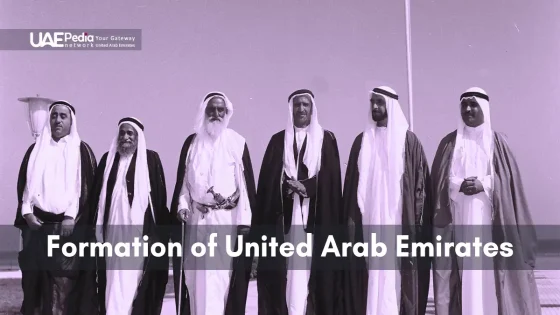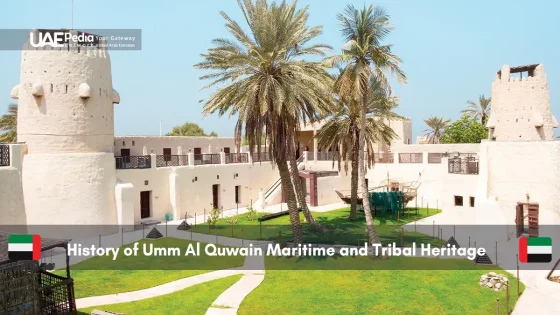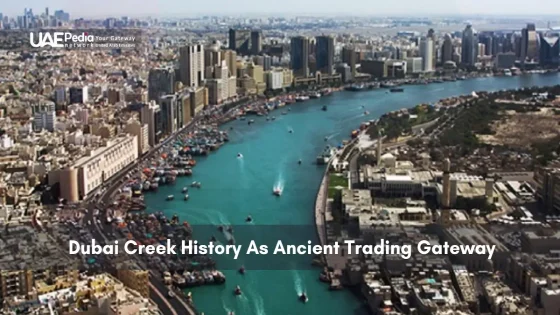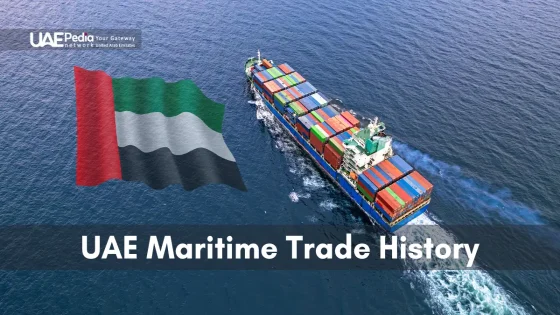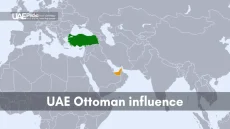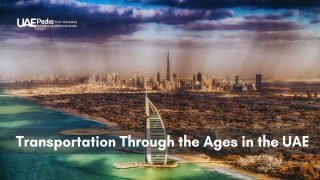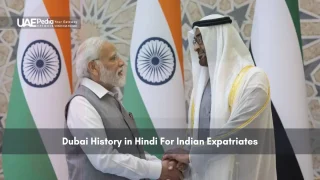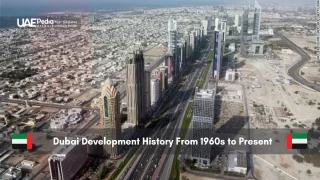The United Arab Emirates (UAE) changed from tribal states to a modern wonder. Seven emirates joined to form a powerful nation. This happened in 1971, changing the Arabian Peninsula forever.
The founding fathers faced many challenges. But they worked hard to unite the UAE. Their efforts created a strong nation.
The UAE’s history began with maritime trade and cultural exchange. For 151 years, the British influenced the area. The General Peace Treaty of 1820 was a key moment.
This treaty aimed to stop piracy and the slave trade. It helped bring stability and growth to the region.
The UAE’s formation is a big deal in Middle East history. Sheikh Zayed bin Sultan Al Nahyan and Sheikh Rashid bin Saeed Al Maktoum led the unification. They turned a desert into a global center for business and culture.
Today, the UAE celebrates its national day on December 2nd. It shows the strength of unity and forward-thinking leadership in the Arabian Peninsula.
Historical Background of the Trucial States
The Trucial States, once known as Trucial Oman, played a key role in the UAE’s history. This coastal area was a center of maritime trade and cultural exchange for centuries.
British Influence and the Trucial States Period
The British arrived in the Gulf in the early 19th century. In 1820, the Trucial States made a peace treaty with Britain. This treaty aimed to stop piracy and keep British ships safe.
By 1892, the rulers of Abu Dhabi, Dubai, Sharjah, Ajman, Ras Al Khaimah, and Umm Al Quwain signed an “Exclusive Agreement” with Britain. This agreement made their ties stronger.
Maritime Trade and Cultural Exchange
Maritime trade was crucial for the Trucial States. Fishing and pearling were big industries in the 19th century. The area’s location helped in cultural exchange, mixing Persian and local traditions.
This mix created a unique identity that still influences the UAE today.
Early Governance Structure
The Trucial States’ governance changed over time. In the late 18th century, the Qasimi dynasty from Ras al-Khaimah became powerful. By the mid-19th century, the Banū Yās tribal confederation, centered on Al-Ain and Līwā, was the most influential.
In 1952, the Trucial States Council was formed. It aimed to help the seven rulers work together, setting the stage for future unity.
| Year | Event |
|---|---|
| 1820 | General Treaty of Peace signed with Britain |
| 1892 | Exclusive Agreement signed with Britain |
| 1952 | Trucial States Council established |
| 1971 | Formation of the United Arab Emirates |
Formation of the United Arab Emirates
The UAE’s birth was a key moment in history. In 1971, the dream of UAE independence came true. It changed the Arabian Peninsula’s politics.
Declaration of Independence
On December 2, 1971, the UAE declared its freedom. This big event came after long talks to unite the emirates. Ras Al Khaimah joined in early 1972, making the Seven Emirates whole.
Sheikh Zayed’s Visionary Leadership
Sheikh Zayed bin Sultan Al Nahyan was key in the UAE’s start. His smart leadership brought the emirates together. Today, the UAE is a modern nation with over 11 million people.
Constitutional Framework
The UAE’s constitution was made in 1971. It set up a system that balances power and freedom. This setup has helped the UAE grow and change over time.
Uniting Seven Distinct Emirates
The unification brought together Abu Dhabi, Dubai, Sharjah, Ajman, Umm Al Quwain, Fujairah, and Ras Al Khaimah. Each kept its own identity but helped the federation grow. Now, the UAE is a strong nation with a high GDP per capita.
Political and Administrative Structure
The UAE has a special way of ruling. It mixes old monarchies with new federal systems. Since 1971, it has seven monarchies, each with its own leader.
Federal Supreme Council UAE
The Federal Supreme Council is key to the UAE’s rule. It has the leaders of all seven emirates. They choose the president and vice-president every five years.
Usually, the Al Nahyan family of Abu Dhabi and the Al Maktoum family of Dubai get these jobs.
Power Distribution in UAE
The UAE’s system gives power to both the federal government and each emirate. The Cabinet, led by a prime minister, handles the country’s affairs. It has 22 members, each covering different areas of governance.
Evolution of Governance Systems
The UAE’s rule has changed a lot since it started. In 2006, a group started picking half of the Federal National Council. This group helps make laws and policies.
In 2008, changes made the FNC more powerful. It works better with the Cabinet now.
| Governance Aspect | Description |
|---|---|
| Political System | Federation of seven monarchies |
| Highest Authority | Federal Supreme Council |
| Legislative Body | Federal National Council (40 members) |
| Executive Body | Cabinet of United Arab Emirates (22 members) |
| Constitution Articles | 152 |
Economic Transformation Post-Unification
The UAE’s economic journey since unification has been amazing. The nation’s GDP hit $545.1 billion by 2024. The per capita income is now $49,560. This growth comes from smart moves and investments in many areas.
The oil industry in UAE is still very important. It helps the country a lot. But, the UAE has also grown in other areas. Dubai is now a big financial center, drawing in businesses and investors from around the world.
UAE global trade has grown a lot, with exports hitting $306.41 billion in 2020. Its good location and modern setup make it a key player in world trade. The UAE trades a lot with GCC countries, India, Japan, and China. This shows how the UAE is connected to the world.
- GDP growth: 7.51% (2022), projected 4.01% (2024)
- Labour force: 6,668,172 (2023), 85% expatriates
- Main industries: Petroleum, petrochemicals, construction materials, textiles
The UAE’s economic change goes beyond old sectors. It’s investing in tourism, tech, and green energy. This shows the UAE’s dedication to growth and innovation. It has made the UAE a strong and forward-thinking economy in the world.
Military Unification and National Defense
The UAE Armed Forces have changed a lot since 1976. This big change helped build a strong defense system. Now, the UAE has great defense skills and a solid military setup.
Armed Forces Unification
On May 6, 1976, the UAE united its armed forces. This was a big moment for the nation’s military plans. Today, the force has 65,000 active soldiers and 130,000 reserves. They make a strong defense team.
Modern Military Capabilities
The UAE really cares about its defense. In 2024, it plans to spend US$24.4 billion on the military. This is 5.6% of the country’s GDP. This money helps the different parts of the military:
- Air Force: About 4,000 people (as of 2017)
- Navy: More than 2,000 people and 72 ships
National Service Program
In 2014, the UAE started its National Service Program. It’s to make people proud and improve defense. Here are some important parts:
- Mandatory service for healthy Emirati men
- 11-month service for high school graduates
- 3-year service for those without a high school diploma
- Optional 11-month service for women
Defense Infrastructure Development
The UAE keeps improving its military setup. It’s updating equipment, better training places, and building strategic bases. These steps keep the UAE Armed Forces leading in security.
Conclusion
The United Arab Emirates (UAE) has grown from a group of Trucial States to a unified nation. This growth Journey shows the power of vision and planning. Since 1971, the UAE has become a global leader, balancing fast growth with a strong national identity.
The UAE’s future looks bright, thanks to its strong economy and diverse industries. It also focuses on innovation. But, the UAE still faces challenges like regional tensions and economic diversification.
Managing these issues is key to the UAE’s long-term success. The country’s role in global diplomacy and trade is also growing. This shows the UAE’s importance on the world stage.
Keeping the UAE’s national identity alive is important, even as it modernizes. Traditional activities like falconry and yola dance mix with new technology. This mix is seen in places like the Hatta Heritage Village and the Burj Khalifa.
As the UAE looks to the future, it must balance its old traditions with new progress. This balance will help the UAE continue to succeed globally.
